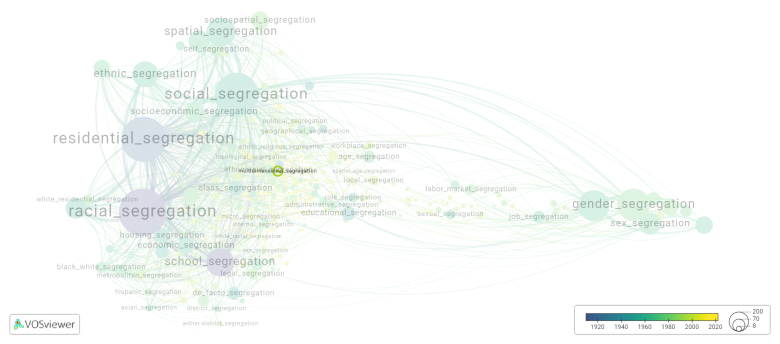Multidimensional segregation: Difference between revisions
(Creating page) |
(Creating page) |
||
| (7 intermediate revisions by the same user not shown) | |||
| Line 5: | Line 5: | ||
Multi-dimensional segregation refers to the separation or isolation of individuals or groups based on multiple factors, such as race, ethnicity, socio-economic status, religion, and age. This type of segregation can occur in various settings, including neighborhoods, schools, workplaces, and communities. Multi-dimensional segregation can lead to unequal access to resources and opportunities, as well as social isolation and discrimination. Addressing multi-dimensional segregation requires comprehensive strategies that address the intersecting factors that contribute to segregation and promote inclusivity and diversity. | Multi-dimensional segregation refers to the separation or isolation of individuals or groups based on multiple factors, such as race, ethnicity, socio-economic status, religion, and age. This type of segregation can occur in various settings, including neighborhoods, schools, workplaces, and communities. Multi-dimensional segregation can lead to unequal access to resources and opportunities, as well as social isolation and discrimination. Addressing multi-dimensional segregation requires comprehensive strategies that address the intersecting factors that contribute to segregation and promote inclusivity and diversity. | ||
===== | ===== Synonyms ===== | ||
The following terms are synonymous with multidimensional segregation: | |||
multi dimensional segregation | multi dimensional segregation. | ||
References and literature addressing this segregation form under these synonymous terms can be found below. | |||
==See also== | ==See also== | ||
==Multidimensional | ==Related segregation forms== | ||
Multidimensional segregation is frequently discussed in the literature with the following segregation forms: | |||
[[residential segregation]] | |||
[[File:multidimensional_segregation.png|780x780px]] | |||
This visualization is based on the study [[Segregation_Wiki:About| The Multidisciplinary Landscape of Segregation Research]]. | |||
For the complete network of interrelated segregation forms, please refer to: | |||
* [https://tinyurl.com/2235lkhw First year of publication] | |||
* [https://tinyurl.com/2d8wg5n3 Louvain clusters] | |||
* [https://tinyurl.com/223udk5r Betweenness centrality] | |||
* [https://tinyurl.com/244d8unz Disciplines in which segregation forms first emerged (Scopus database).] | |||
==References== | ==References== | ||
==Notes== | ==Notes== | ||
<references /> | <references /> | ||
{{NoteAI}} | {{NoteAI}} | ||
==Multidimensional | ==Multidimensional segregation appears in the following literature== | ||
Goldhaber R., Schnell I. (2007 | Goldhaber R., Schnell I. (2007). A model of multidimensional segregation in the Arab Ghetto in Tel Aviv Jaffa. ''Tijdschrift voor Economische en Sociale Geografie'', ''98''(5), 603-620. https://doi.org/10.1111/j.1467-9663.2007.00428.x | ||
Zhang W., Wang Y. (2021 | Zhang W., Wang Y. (2021). Characterising Social Integration Between Rural Migrants and Local Residents in Urban China: An Exploratory Social Network Analysis of Care Workers in Shanghai. ''Urban Book Series'', 233-250. Springer Science and Business Media Deutschland GmbH.https://doi.org/10.1007/978-3-030-74544-8_12 | ||
Latest revision as of 07:17, 16 October 2024
Date and country of first publication[1][edit | edit source]
2007
Israel
Definition[edit | edit source]
Multi-dimensional segregation refers to the separation or isolation of individuals or groups based on multiple factors, such as race, ethnicity, socio-economic status, religion, and age. This type of segregation can occur in various settings, including neighborhoods, schools, workplaces, and communities. Multi-dimensional segregation can lead to unequal access to resources and opportunities, as well as social isolation and discrimination. Addressing multi-dimensional segregation requires comprehensive strategies that address the intersecting factors that contribute to segregation and promote inclusivity and diversity.
Synonyms[edit | edit source]
The following terms are synonymous with multidimensional segregation:
multi dimensional segregation.
References and literature addressing this segregation form under these synonymous terms can be found below.
See also[edit | edit source]
Related segregation forms[edit | edit source]
Multidimensional segregation is frequently discussed in the literature with the following segregation forms:
This visualization is based on the study The Multidisciplinary Landscape of Segregation Research.
For the complete network of interrelated segregation forms, please refer to:
References[edit | edit source]
Notes[edit | edit source]
- ↑ Date and country of first publication as informed by the Scopus database (December 2023).
At its current state, this definition has been generated by a Large Language Model (LLM) so far without review by an independent researcher or a member of the curating team of segregation experts that keep the Segregation Wiki online. While we strive for accuracy, we cannot guarantee its reliability, completeness and timeliness. Please use this content with caution and verify information as needed. Also, feel free to improve on the definition as you see fit, including the use of references and other informational resources. We value your input in enhancing the quality and accuracy of the definitions of segregation forms collectively offered in the Segregation Wiki ©.
Multidimensional segregation appears in the following literature[edit | edit source]
Goldhaber R., Schnell I. (2007). A model of multidimensional segregation in the Arab Ghetto in Tel Aviv Jaffa. Tijdschrift voor Economische en Sociale Geografie, 98(5), 603-620. https://doi.org/10.1111/j.1467-9663.2007.00428.x
Zhang W., Wang Y. (2021). Characterising Social Integration Between Rural Migrants and Local Residents in Urban China: An Exploratory Social Network Analysis of Care Workers in Shanghai. Urban Book Series, 233-250. Springer Science and Business Media Deutschland GmbH.https://doi.org/10.1007/978-3-030-74544-8_12

